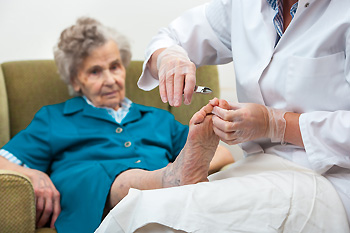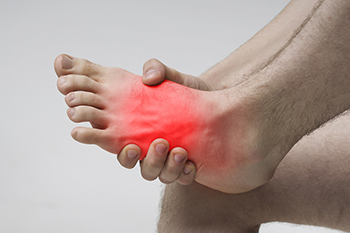A chiropodist is a highly trained healthcare professional that provides the assessment, treatment, and management of chronic or acute foot and ankle problems. They aid in the prevention of injuries and disabilities and promote proper foot health for overall well-being. With foot problems being as prevalent as they are, the fact that the feet are the body’s foundation, and the necessity of keeping our feet as healthy as possible, chiropodists are needed to help with prevention, assessment, and treatment of issues that may arise with feet. When the feet are properly supported, the whole body works better. Chiropodists must have seven to eight years of post-secondary school before beginning to practice. They must obtain a bachelor’s degree in science and take a three to four year chiropody program. Chiropodists work independently or as part of a team. Chiropodists treat a variety of foot problems including bony foot deformities, corns, calluses, warts, fungal infections, nail conditions, and biomechanical dysfunctions. These healthcare providers also recommend or provide orthotics and insoles. They might also provide physical therapy, surgical procedures, injection administration, prescriptions, and various other therapies. Normally one sees a chiropodist when they are experiencing pain. However, visiting one regularly, as one would a dentist, can help ensure the feet are in top form and will help prevent future problems. If you suffer from foot or ankle pain or have questions about your lower extremities, book an appointment with a chiropodist.

Seeking the expertise of a chiropodist can yield numerous benefits that contribute to overall health and comfort for your feet. Chiropodists are trained in theoretical, clinical, and practical aspects of foot and ankle disorders. They play a vital role in addressing a range of foot health issues, including flat feet, bunions, heel and arch pain, nail fungus, warts, and diabetic foot conditions. They also can provide personalized recommendations for custom footwear and orthotics, enabling patients to alleviate specific foot conditions. During your visit to a chiropodist, be prepared to discuss your medical history, which helps this medical professional to fully understand your condition. Today's leading chiropodists are committed to delivering optimal foot care, and promoting overall well-being. Complying with lifestyle modifications and recommendations from a chiropodist can expedite the recovery process, enabling you to embrace improved foot health and enhanced quality of life. If you have specific foot problems, it is suggested that you make an appointment with a chiropodist for treatment and guidance.
If you have any foot or ankle concerns, contact one of the chiropodists of The Footcare Centre. Our chiropodists can provide the care you need to keep you on your feet.
A chiropodist is a healthcare professional that specializes in the feet, ankles, and lower limbs. With the amount of work the feet do in a lifetime, the whole body works better if the feet are properly supported. Chiropodists must have a bachelor’s degree in science and complete a three to four-year chiropody program. They can then work independently or as part of a team. Chiropodists are like podiatrists, the only difference being the country they obtained where they obtained their degrees. The field can be called podiatry in the United States and chiropody elsewhere. A chiropodist is a popular term for this profession in the UK and Canada. Chiropodists treat a variety of foot problems from corns and calluses to fungal infections. Some also offer orthotics. They might provide a variety of foot therapies, injections, and surgical procedures. Normally one sees a chiropodist when they are experiencing pain but visiting one regularly, as one would a dentist, can help ensure the feet are in top form and help prevent future problems. If you suffer from foot or ankle pain or have questions about your lower extremities, book an appointment with a chiropodist today.
What Does a Chiropodist Do?
A chiropodist helps people with problems with their feet and ankles with the goal of making their lives more comfortable. A chiropodist takes care of blisters, corns, bunions, cracked heels, nail problems, and sprained ankles, just to mention a few things that can go wrong with our feet. A chiropodist will take your medical history and examine your feet for blood circulation and any other problems going on. They will watch you walk and how you move when you walk. They will discuss any findings they come up with and discuss a treatment plan with you.
What Does It Take to Become a Chiropodist?
Chiropodists must have seven to eight years of post-secondary school before beginning to practice. They must obtain a bachelor’s degree in science and complete a three-to-four-year chiropody program. Chiropodists work independently or as part of a team.
If you have any questions please feel free to contact our office located in Niagara Falls, ON . We offer the newest diagnostic tools and technology to treat your foot and ankle needs.
Sever’s disease, also known as calcaneal apophysitis, is a foot condition that occurs in children. Sever’s disease is not truly a disease, but rather an overuse injury. It is common among active children between the ages of 8 and 14. Young, growing children have a growth plate in their heels, where new bone is forming. When too much stress is put on the heel, the growth plate can become inflamed, leading to heel pain.
Children who participate in activities that put repetitive stress on the heel bone are most at risk of developing Sever’s disease. These activities include playing soccer or basketball, running track, or any other sport or activity that involves running, jogging, or jumping. Children who are obese, have tight Achilles tendons, biomechanical problems, flat feet, or fallen arches are also at risk.
The symptoms of Sever’s disease include pain in the back or bottom of the heel, pain when the sides of the heel are squeezed, and fatigue. The pain may lead to difficulties walking or bearing weight on the affected foot, and you may notice your child limping or walking on their toes to avoid putting pressure on the heel. A chiropodist can diagnose Sever’s disease by taking a medical history and performing a physical examination. Imaging studies such as X-rays may also be ordered.
Sever’s disease is generally treated by resting the affected foot, wearing shoes or orthotics that support the heel, and taking nonsteroidal anti-inflammatory medications to reduce pain and inflammation. In severe cases of heel pain, the affected foot may need to be immobilized with a cast while it heals. If your child is complaining of heel pain, please consult with a chiropodist.

Sever's disease, also known as calcaneal apophysitis, is a common source of heel pain in physically active young individuals, typically emerging during puberty. It occurs more frequently in boys than girls and has no known single cause but likely results from factors like overuse and increased body weight. This condition involves the Achilles tendon's attachment to the heel bone, which is still in the process of changing from cartilage to bone in pre-teens. Symptoms include heel pain during physical activity, worsened pain after exercise, limping, and tiptoeing. Several factors contribute to Sever's disease, including changes in height, weight, increased physical activity volume, type of activity, and footwear choices. Treatment varies based on the level of pain and may include activity modification, load management, heel raises, orthotics, and time for the condition to improve. If your child has heel pain, it is suggested that you make an appointment with a chiropodist for a proper diagnosis and treatment options.
Sever’s disease typically affects young children and teenagers. If your child complains of foot pain, please consult with one of the chiropodists from The Footcare Centre. Our chiropodists will assess your condition and provide you with quality foot and ankle treatment.
What Is Sever’s Disease?
Sever’s disease, also known as calcaneal apophysitis, is an inflammation of the growth plate in the heel bone. It is typically caused by overuse due to repetitive activities such as running, jumping, and playing certain sports. This condition most frequently affects children between the ages of 8 and 14.
Symptoms
Symptoms of Sever’s disease include:
Pain in the back or bottom of the heel
Pain when the sides of the heel are squeezed
Limping or walking on tiptoes to avoid putting pressure on the heel
Difficulty running, jumping, or participating in usual activities
Fatigue
Diagnosis
Sever’s disease is diagnosed by taking a thorough medical history and performing a physical examination. Imaging studies, such as an X-ray, can help rule out other injuries like a fracture.
Treatment
Sever’s disease typically heals without any long-term complications. Treatment involves resting the affected foot by reducing typical activities, wearing orthotics to support the foot, immobilizing the affected foot, taking medications to reduce pain and inflammation, and stretching the foot.
If you have any questions, please feel free to contact our office located in . We offer the newest diagnostic and treatment technologies for all your foot care needs.
Stress fractures are small, fine cracks that can happen in the bones of the feet. Stress fractures occur when the affected bones are not able to bear the weight placed on them. They are often the result of repetitive overuse and injury from activities such as running, jumping, or dancing and are therefore common in athletes. Stress fractures are also more likely to occur in people who have other health conditions, such as osteoporosis, bunions, tendinitis, or abnormal foot biomechanics.
While stress fractures can occur in any bone in the foot, they are most common in the metatarsal bones, the calcaneus bone, and navicular bone. The metatarsal bones are in the center of the foot and connect the toes to the rest of the midfoot region. The second and third metatarsal bones, which connect the second and third toes to the midfoot, are the most likely bones to incur a stress fracture. The calcaneus, or heel bone, is located at the back of the foot and is the second most common site of stress fractures in the feet. The navicular bone is located near the top of the foot.
The symptoms of a stress fracture include pain, tenderness, weakness, bruising, and swelling. This can lead to difficulty putting weight on the affected foot, which may change your gait or manner of walking. Symptoms usually have a gradual onset and become progressively worse over time. Without treatment, a stress fracture may progress to a full fracture, in which the bone breaks completely. The affected bone can also move out of proper alignment, causing more pain.
Stress fractures are diagnosed through a physical examination. Imaging studies, such as X-rays, bone scans, ultrasounds, or MRIs may be needed to confirm the diagnosis or to rule out other causes for your symptoms. Treatment for a stress fracture depends on the severity of the injury. You may be asked to cease certain weight-bearing activities and to rest, ice, compress, and elevate the affected foot to help it heal. Protective footwear, a cast, or crutches may be provided to protect and stabilize your foot while it heals. Surgery may be necessary if the stress fracture has occurred in an area that does not typically heal well through non-surgical means, such as the sesamoid bones.
If you are experiencing the symptoms of a stress fracture in your foot, please consult with a chiropodist.

Foot stress fractures, which are hairline cracks in the bones of the foot, can often bring athletic activity to a halt. Stress fractures, primarily a result of repetitive strain, stem from several factors. The key trigger for foot stress fractures is the excessive force applied to foot bones during rigorous activities, such as running, jumping, and fast-paced sports. The foot's repetitive impact on hard surfaces initiates the problem, making runners, football players, and gymnasts highly susceptible. Despite the seemingly tiny nature of these fractures, they can lead to immense pain and discomfort. Inadequate muscle support also plays a role in foot stress fracture formation. When individuals rapidly escalate their activity levels, such as taking up a new sport or intensifying training, the muscles may lack the necessary strength and endurance to support it. This deficiency compromises the support of the foot bones, resulting in an overload of force onto them. This then can lead to small cracks forming within the bones. If you believe you have developed stress fractures in your feet, it is suggested that you consult a chiropodist for an exam and treatment options.
A stress fracture often requires medical attention as it can progress and worsen over time. Please consult with one of the chiropodists from The Footcare Centre. Our chiropodists will assess your condition and provide you with quality foot and ankle treatment.
A stress fracture refers to a fine crack in a bone. This type of fracture is especially common in the feet, as they often endure repetitive pressure from daily activities such as walking or running. Stress fractures occur when the affected bone can not support the load being placed on it. Stress fractures in the foot can occur in any bone, but often affect the metatarsal bones which connect the toes to the rest of the foot, the heel bone, or the navicular bone on the top of the foot.
Symptoms
Symptoms of a stress fracture may include:
Deep, dull pain
Sharp, localized pain
Intermittent pain
Tenderness
Weakness
Swelling
Bruising
Changes in the biomechanics of the foot
Diagnosis
Stress fractures in the foot are diagnosed via medical history and a physical exam. You may also need to have diagnostic imaging tests like X-rays, MRIs, CT scans, bone scans, or an ultrasound performed to confirm the diagnosis and to rule out any other problems.
Treatment
Nonsurgical treatment options include resting, icing, compressing and elevating the affected foot, taking nonsteroidal anti-inflammatory pain medications, modifying your footwear, wearing a cast, and using crutches. Certain types of foot fractures, such as navicular fractures, respond poorly to nonsurgical treatment and may need surgery to fully heal.
If you have any questions, please feel free to contact our office located in . We offer the newest diagnostic and treatment technologies for all your foot care needs.
A sprained ankle is a common injury that can happen to anyone. Whether you incur it while playing a high-impact sport or from simply stepping off of a curb and twisting your ankle, it’s important to know and recognize the symptoms of a sprain and get the appropriate treatment.
Ankle sprains occur when a sudden injury causes one or more of the ligaments that support the ankle to overstretch or tear. The symptoms that you may face depend on the severity of the injury. A mild, grade 1 sprain usually involves minimal pain, swelling, tenderness, and bruising, with no difficulty walking. A moderate, grade 2 sprain may be significantly more painful, with visible swelling and bruising, ankle instability, and a limited range of motion in the ankle. Walking or bearing weight on the affected ankle can be difficult. A severe, grade 3 sprain is characterized by intense pain, swelling, bruising, ankle instability, and a severely limited range of motion. Walking with a grade 3 sprain is often impossible.
A chiropodist can diagnose an ankle sprain by asking for your medical history and carefully examining the affected ankle. They may order an X-ray to rule out a fracture. Treatment for the sprain depends on its severity. Milder ankle sprains can often be treated with conservative methods such as resting, icing, elevating, and compressing the ankle. More severe sprains may require wearing a brace or other orthotic device to take pressure off of the injured ankle. Over-the-counter medications are typically sufficient for managing pain. In very rare cases, surgery may be needed to repair a ligament that is not healing properly.
A sprained ankle needs to heal fully and properly in order to avoid reinjury and other complications. If you have sprained your ankle, please seek the care of a chiropodist.

Ankle sprains, a common injury, can occur when the ligaments connecting the bones in the ankle stretch or tear due to sudden twisting or rolling movements. Symptoms of an ankle sprain include pain, swelling, and tenderness around the affected area. Bruising may develop, and walking can be challenging, if not impossible. Prompt treatment is essential, and can begin with rest and wrapping the affected foot, and elevating it to reduce the swelling. Performing gentle exercises and stretches can help regain strength and flexibility. Depending on the severity, a medical professional might recommend braces, crutches, or physical therapy. Restoring full functionality involves diligent adherence to the prescribed rehabilitation plan. Understanding the symptoms and promptly seeking appropriate care can facilitate a smoother recovery from this discomforting setback. It is suggested that you see a chiropodist if you suffer from an ankle sprain.
When one or more ligaments in the ankle overstretch or tear due to injury, an ankle sprain occurs. If you would like to learn more about ankle sprains, please consult with one of the chiropodists from The Footcare Centre. Our chiropodists can help you maintain the health of your lower limbs and your mobility.
Symptoms of an ankle sprain vary depending on the severity of the injury, but may include:
Pain
Swelling
Bruising
Tenderness
Difficulty walking
Ankle instability
A reduced range of motion in the ankle
Treatments for an ankle sprain may consist of:
Resting the injured ankle
Applying ice
Elevating the ankle
Compressing the ankle
Over-the-counter pain medications
Ankle braces or other devices to take weight off of the ankle
Ankle exercises
Surgery (in rare cases)
It’s important for the sprained ankle to heal correctly and fully in order to avoid repeated injury. If you have any questions, please feel free to contact our office located in . We offer the newest diagnostic and treatment technologies for all your foot care needs.
If you’re suffering from foot pain, it’s important to note the locations and quality of your foot pain. Pain can affect any part of the foot, including the top, bottom, side, heel, or toes. The pain may be sharp, stabbing, dull, achy, burning, or stinging, and can come on suddenly or develop gradually over time.
Pain in the top, bottom, or side of the foot can have many causes. In addition to the type of pain and its location, it’s also important to note when the pain started, what you were doing at the time, and what aggravates the pain. For example, pain in the top of the foot that worsens with physical activity or weight-bearing, that has gradually gotten worse over time, and is accompanied by swelling and tenderness could be indicative of a stress fracture.
Pain in the heel is a frequent concern, especially among patients who participate in sports, run, or wear high heels. Plantar fasciitis, an inflammation of the ligament that runs along the bottom of the foot and connects the heels to the toes, can cause stabbing heel pain. The pain is usually at its worst upon taking your first few steps in the morning or after a long rest and can radiate to the arch of the foot. Plantar fasciitis is also often associated with heel spurs, bony outgrowths on the heel bones that can be painful if they poke into the surrounding tissues.
Foot pain can be caused by not only injuries but also problems with the biomechanics of the feet and underlying health problems, like diabetes or peripheral neuropathy. If you’re experiencing foot pain, please seek the care of a chiropodist near you.

